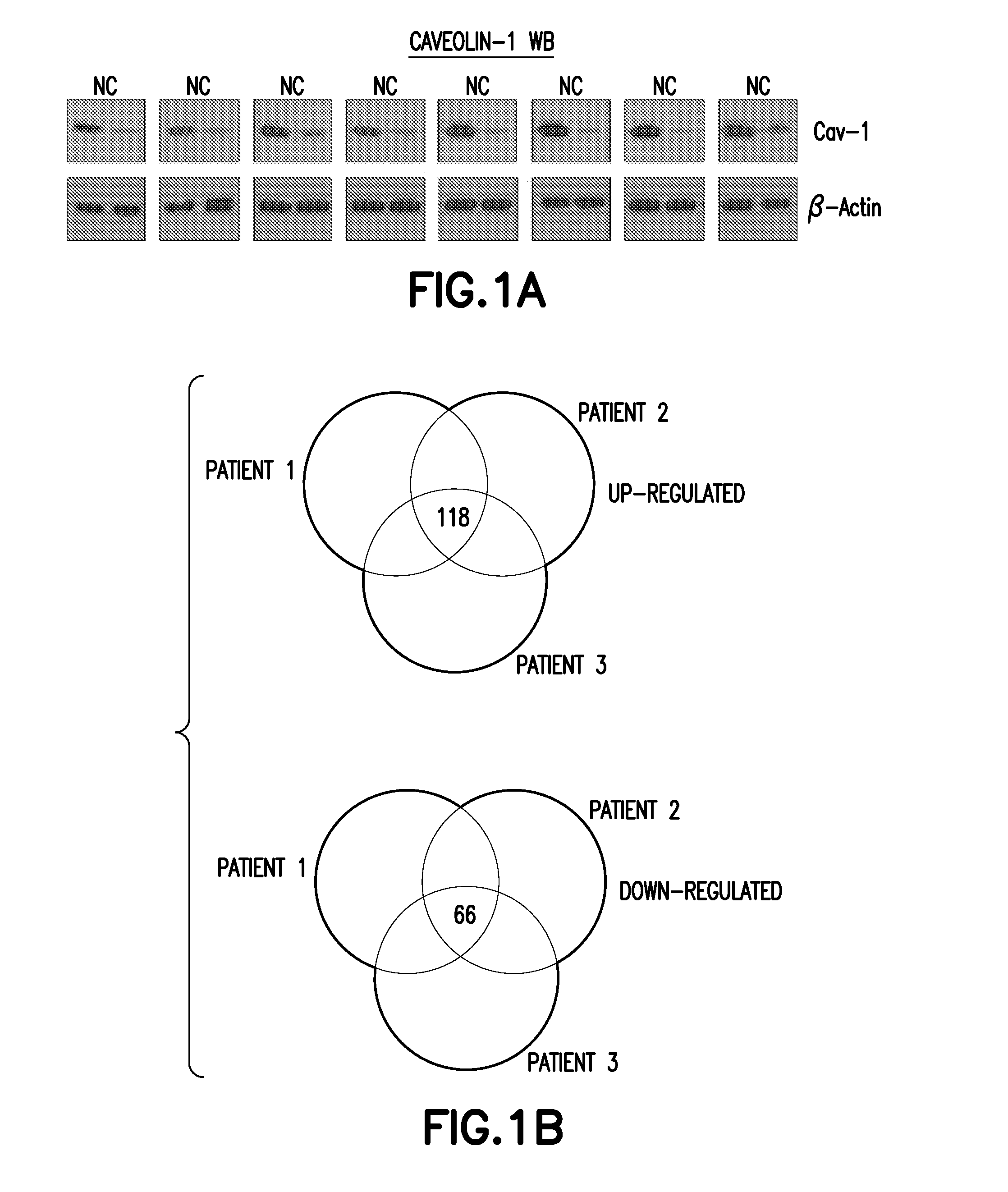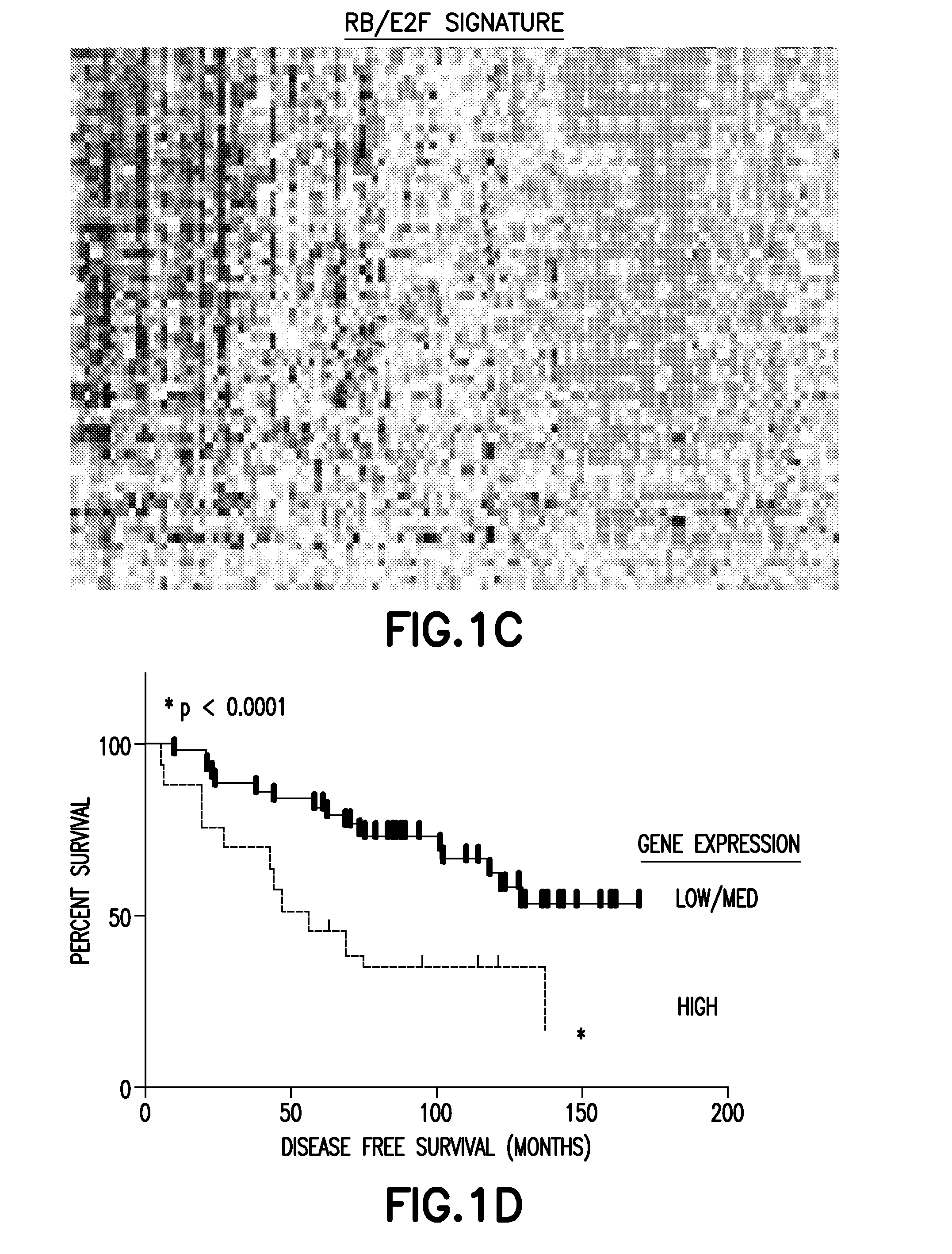Method of Diagnosis or Prognosis of a Neoplasm Comprising Determining the Level of Expression of a Protein in Stromal Cells Adjacent to the Neoplasm
a stromal cell and protein technology, applied in the field of stromal caveolin, can solve the problems of unresolved relationship between disease outcome and fibroblasts, inability to address the clinical significance of stromal cav-1 expression in invasive breast cancer in vivo, and poorly understood mechanisms that govern the conversion of benign mammary stromal fibroblasts to tumor-associated fibroblasts
- Summary
- Abstract
- Description
- Claims
- Application Information
AI Technical Summary
Benefits of technology
Problems solved by technology
Method used
Image
Examples
example 1
Clinicopathologic Features of the Specimens
[0300]Of the 160 invasive carcinomas used to construct the TMA, 154 had at least 2 cores available for evaluation. Therefore, our study population consists of 154 women with a median age of 59.5 years (range 28-96 years). 85% of the women were white. The median follow-up time for all survivors was 8.4 years and the median time to metastasis, death, or last visit was 7.1 years. 45% of the subjects underwent Tamoxifen treatment after diagnosis, and 31% had a recurrence of breast cancer during follow-up.
example 2
[0301]ER, PR, HER2, and Stromal Cav-1 Expression Analysis of the Specimens. One hundred forty patients were evaluated for ER, PR and HER2, of whom 66% were ER+ and 15% were triple-negative. One hundred and twenty five patients had samples that could be scored for stromal Cav-1. We established a Cav-1 grading scale (0, 1, and 2), with 0 representing an absence of stromal Cav-1 and 2 representing high levels of stromal Cav-1.37% of the samples showed a loss / or absence of stromal Cav-1 (score=0). A median score of 0 was interpreted as an absence of stromal Cav-1, and scores of 1 and 2 were interpreted as the presence of stromal Cav-1. Normal human breast tissue (TDLUs; terminal ductal lobular units) is shown for comparison purposes. Note that the intralobular mammary stroma, the vasculature, and myo-epithelial cells are normally Cav-1 positive. Tables 2 and 3 show the relation of stromal Cav-1 expression to various clinico-pathological variables.
example 3
[0302]Stromal Cav-1 Expression Correlated to Pathologic Features. We find that an absence of stromal Cav-1 is strongly associated with tumor stage and nodal stage, as well as with recurrence rate and number of lymph node metastases. Loss of stromal Cav-1 is also significantly associated with lymphovascular invasion (LVI) (Table 4). In all cases, the absence of Cav-1 is associated with markers of more aggressive disease (higher T-stage, higher N-stage, higher recurrence rate, more positive lymph nodes, and the presence of LVI) (Tables 2 and 4). For example, patients with stromal Cav-1 expression showed an ˜3.6-fold reduction in disease recurrence and a ˜2-fold reduction in lymph node metastasis. Interestingly, patients with high stromal Cav-1 (score=2) showed an ˜5-fold reduction in disease recurrence and a ˜2.6-fold reduction in lymph node metastasis (See Table 1). However, there was no association between stromal Cav-1 expression and tumor grade. Stromal Cav-1 was also not associat...
PUM
| Property | Measurement | Unit |
|---|---|---|
| area | aaaaa | aaaaa |
| temperature | aaaaa | aaaaa |
| temperature | aaaaa | aaaaa |
Abstract
Description
Claims
Application Information
 Login to View More
Login to View More - R&D
- Intellectual Property
- Life Sciences
- Materials
- Tech Scout
- Unparalleled Data Quality
- Higher Quality Content
- 60% Fewer Hallucinations
Browse by: Latest US Patents, China's latest patents, Technical Efficacy Thesaurus, Application Domain, Technology Topic, Popular Technical Reports.
© 2025 PatSnap. All rights reserved.Legal|Privacy policy|Modern Slavery Act Transparency Statement|Sitemap|About US| Contact US: help@patsnap.com



